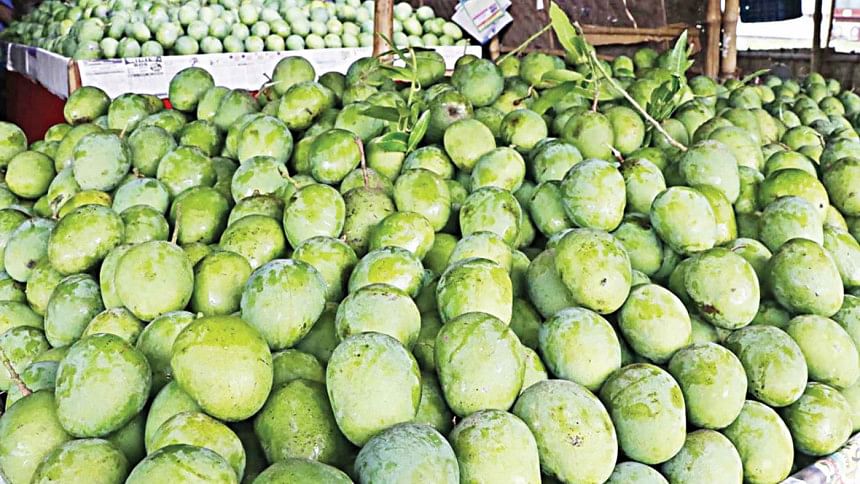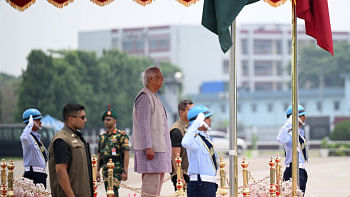Mango in Rajshahi Belt: Despite good yield, growers not all smiles

A drought without incessant rains or severe storms have blessed four mango-producing districts in Rajshahi division with good yields but the region's farmers are yet to see good fortune.
Mango trees on 83,673 hectares of land in Natore, Naogaon, Rajshahi and Chapainawabganj are expected to yield 8.52 lakh tonnes of mangoes this year.
Last year, the region's mango production was 7.76 lakh tonnes after fruit loss during storms, Department of Agricultural Extension (DAE) officials said.
If no major calamity occurs till mid-July, the region's mango production is likely to increase by nearly one lakh tonnes this year, said Sirajul Islam, additional director of DAE.
Mango production in the region is worth Tk 2,500 crore while some three lakh farmers, according to DAE data, and thousands others work in the trade.
"The drought has helped the mangoes this season," said Dr Alim Uddin, principal scientific officer of the Fruit Research Centre in Rajshahi.
Almost no fruit has fallen in large quantities from mango trees as no severe storm has occurred so far while pest attacks remained low due to the lack of rains, he said. While the drought may cause mangoes to "shrink" a bit if not given irrigation, he added, yield and sweetness will not be impacted.
But the region's farmers, who grow around 40 percent of the country's mangoes, could not celebrate as many complained of being deprived of fair prices due to the lack of buyers amid the coronavirus situation.
Besides, taking advantage of the pandemic, local traders are manipulating the markets, said agriculturists and farmers.
As no buyers from outside the districts are visiting the region, farmers are being forced to sell off their mangoes only to local traders who are buying from their orchards.
The district administration of the highest mango-producing district, Chapainawabganj, closed its borders with a seven-day lockdown until the end of May, which is the season of the Guti and Gopalbhog varieties.
While a special restriction on travel in and out of the district still applies till June 16, the district's Covid-19 control committee has relaxed it for mango traders.
But farmers said the relaxation does not improve the situation for them as buyers did not visit the districts while local traders continued to buy their mangoes at low prices.
In the beginning of this month, when the quality mango varieties of Khirsapat and Himsagar began appearing in local markets, the country's largest wholesale mango market, in Kansat, was far from its usual form.
Usually, each of more than 800 wholesalers of Kansat market would deal with over a dozen buyers from across the country and some 200 trucks loaded with mangoes would depart from the district every day.
Now, no more than 30 wholesale traders have opened their shops so far while only a handful of trucks are transporting mangoes outside the district, said Omor Faruk Tipu, a mango trader.
He, however, said the situation improved since June 1 when around 150 trucks hired by the traders gathered at the wholesale shops to be loaded with mangoes.
"Traders like me are managing buyers online or via phone, but the farmers are remaining deprived of fair prices," Tipu said.
Guti mangoes that sold at Tk 38,000 per tonne at the beginning of the season in mid-May, are now selling at Tk 18,000 a tonne in Chapainawabganj.
Gopalbhog mangoes, sold at Tk 55,000 per tonne a week ago, are now being sold for as low as Tk 32,500 a tonne.
On the morning of June 1, Khirsapat and Himsagar varieties that were sold at Tk 60,000 a tonne witnessed a price fall of Tk 15,000 per tonne that very afternoon at Kansat market over mounting supply.
Many traders have begun advertising their mangoes online, said Ismail Hossain Khan, who runs a Facebook group of around 600 traders called Online Mango Traders of Bangladesh.
"Large traders are at ease, but small farmers are being forced to sell their mangoes to local traders only at low prices," Ismail said.
OTHER DISTRICTS FARING SLIGHTLY BETTER
The situation in Rajshahi, Natore and Naogaon is however better than Chapainawabganj as no lockdown was imposed in those districts.
But district administrations are facing pressure from health officials to impose restrictions to prevent the spread of coronavirus, officials said.
In absence of lockdowns, mangoes abounded in the country's second largest mango market in Baneshwar of Rajshahi, but farmers here complained of a lack of buyers too.
During a visit to Baneshwar recently, this correspondent saw farmers waiting for long times with their mangoes in the scorching heat for scarce buyers.
Abdul Kuddus, a farmer from Charghat, was one of them.
"Some buyers offered me a price, but I'm waiting for a little more," he said, adding that he encountered only local buyers, no one from outside the district.
"Normally, mangoes are sold directly from my orchard or the traders buy mangoes from me on my way to the markets," he said.
"Prices are low when we take mangoes to markets for selling, but when we go to buy, mango prices soar up," Joynal Abedin, another farmer said, alleging manipulation by the traders.
The Laxmanbhog variety of mangoes, which sold at Tk 40,000 per tonne last year, is being sold at a maximum of Tk 22,500 per tonne this season.
"Buyers are visiting us from different parts of the country, but their numbers are lower than usual," said Nazrul Islam, a mango trader in Baneshwar market.
He claimed the prices this year are good, but acknowledged that the farmers were not getting fair prices as compared to the traders.
The highest quality mango variety, Langra, appears in markets in the second week of June and the king of mangoes, Fazli, at the end of June.

 For all latest news, follow The Daily Star's Google News channel.
For all latest news, follow The Daily Star's Google News channel. 



Comments